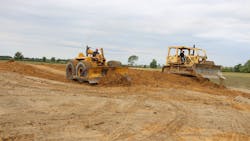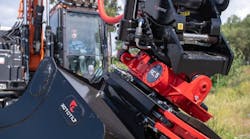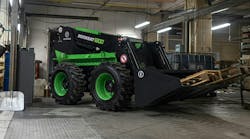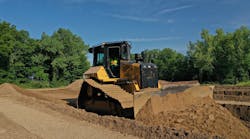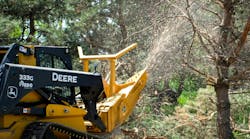Originally developed for agriculture and cargo handling, crawler tractors quickly proved their suitability and versatility as construction machines. They could be used bare or equipped only with a cable control unit for pulling scrapers and other equipment; blades and other attachments enabled them to push and spread. Other attachments included loaders, booms, and cranes; the power takeoff allowed it to power other equipment.
But they had three drawbacks. One was speed. They could go almost anywhere, but they were slow. Another was the damage the crawlers could do to paved surfaces; “street pads” without cleated grousers alleviated this but cost the tractor in traction off the pavement. Finally, although the crawlers could traverse all manner of material, they were prone to expensive wear, especially in rock and abrasive sand. The wear was exacerbated by careless operation that caused the crawlers to lose purchase.
The great equipment innovator R. G. LeTourneau had an idea to address this, as he did for many other problems. His solution was to mount a dozer blade onto a wheel tractor. The rubber tires let it move faster than a crawler tractor; they protected surfaces upon which they worked; and in sandy material they eliminated the maintenance costs of crawlers while often providing better flotation and traction.
Read also: How earth was moved for the Golden Gate Bridge
His prototype, mounted on the back of a John Deere D industrial tractor in 1936, was only a hint of what was to come. In late 1945, he unveiled the world’s first successful wheel dozer. This machine was powered by a 300-horsepower Buda diesel engine, with a generator to provide electricity for control of the blade. It was designed exclusively for pushloading scrapers. Only one was built, but it was the launching point for dozers rated from 85 to 750 horsepower.
The most successful model of the line by a wide margin was the C, introduced in 1946 and rated in the 200-horsepower range for most of its long production life. Although certainly suitable for pushloading, it was also much more versatile, suitable for all manner of applications other than working in rock that attacked the tires. As had been done with crawler tractors, LeTourneau (and, later, LeTourneau-Westinghouse) offered various attachments for it, including a sideboom, snow plow and wing, log skidding package, bumper and push plate, “Stinger” tree pusher, root rake, and a “switchtractor” railroad car coupler. It was also marketed for pulling rollers, scrapers, and the distinctive Tournacrane towed cranes.
